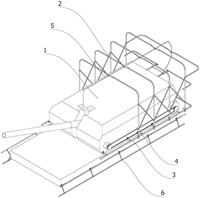When the Wind Blows, the Drone Takes Flight: China’s drone and anti-drone military capabilities
China’s accelerating investment in drone and counter-drone technologies reveals both its response to contemporary warfare and its intent to consolidate technological dominance. The rapid evolution of battlefield dynamics has offered a real-time laboratory for military innovation, and Beijing has been quick to learn lessons from modern conflicts and implement new solutions. These developments not only signify a strategic shift in China’s military doctrine but also align closely with its industrial and economic strengths, suggesting a fusion of defence modernization and economic ambition.
Funding
The People’s Liberation Army’s (PLA) growing focus on drone warfare emerges against the backdrop of ballooning defence budgets. Official figures place China’s 2025 military spending near $247 billion, though independent estimates suggest the true number may exceed $471 billion [1]. Overall, discussion on estimates for the budget is highly contentious and confusion caused by the suspicion of China's under-reporting works to the PLA's advantage. One source released their calculations that spending totals for 2022 may have been over 700 billion, on par with the USA [2].
This vast pool of funding has enabled diversification in the PLA’s modernisation agenda, particularly in unmanned systems, which have received a significant cash injection over the past few years [3]. The use of drones in conflicts such as Ukraine has exposed vulnerabilities in traditional air defences, showing that low-cost, small drones can neutralize much more expensive systems [4]. Chinese planners, recognizing this asymmetry, have shifted focus to technologies that can overwhelm or outmanoeuvre conventional defences.
Discovering Drone Versatility
China’s drone capabilities now span air, land, and sea. During the 2025 China-Cambodia Golden Dragon exercises, infantry units deployed FPV (First Person View) drones and robotic dogs armed for reconnaissance and attack, including a UAV fitted with a QBZ-95 rifle to support ground troops [5]. Naval developments such as the 18-meter AJX-002 extra large unmanned underwater vehicle (XLUUV), signals intent to expand subsurface capabilities without the expense of human crew [6] [7].

Finally, the unveiling of the Hongdu GJ-11 Sharp Sword (攻击-11 利剑;), designed to fly alongside manned fighters and provide additional firepower to attacks [7], highlights an ambitious integration of manned and unmanned airpower.
Techniques such as swarming may be used to significantly increase the scale of effect for military drone operations, however these tactics require a controlled and coordinated launch procedure. Companies specialising in drone light shows for events may hold the answer for mass deployment of drones at a rapid pace [8], applicable to both entertainment and combat scenarios. Technology such as this demonstrates the strength and unpredictability of Chinas military-civil development model.
The Anti-UAV 'Iron Triangle'
Equally important is China’s response to the drone threat itself. The Ukraine war demonstrated how drones can overwhelm traditional air defence systems, prompting China to develop specialized counter-UAV platforms. These new arrays of defensive systems have been likened to an 'iron triangle' [13] where both physical and energy-based techniques provide wider coverage.
Physical Anti-UAV designs reflect an understanding that future air defence must emphasize volume, flexibility, and automation rather than singular, high-cost intercepts. For example:
• The CASIC-developed FK-3000 system (FK-3000弹炮合一防空系统), built to tackle drone swarms like Iran’s Shahed models, combines a 30 mm cannon with short-range missiles and radar-guided fire control for multi-target engagement [9].
• Norinco’s Bullet Curtain (弹幕系统)uses 35 mm air-burst rounds to create a lethal cloud against drone swarms, integrating radar and optical sensors for adaptive fire control [10]
Directed-energy weapons represent another frontier. Microwave systems, such as the Hurricane-3000 by Norinco, interfere with electronic components to neutralise drones up to or even beyond 3km away [11]. High-energy lasers and microwave systems, such as the Shen-Nong Shield 3000 (神农盾3000)[12], can disable or destroy drones by burning through their structure or electronics. Unlike missile-based systems, these technologies offer virtually unlimited “ammunition” at minimal cost, ideal for repelling massed attacks [13]. One such X user indicates that the Shen-Nong Shield might be actively deployed on the front lines of the Russia-Ukraine conflict [14].

China has also borrowed examples of defensive improvisations. Ukrainian forces’ “hood” armour upgrades for tanks (simple metal shields that block top-attack drones) have inspired Chinese patents for similar designs marketed as the Dragon Shield [15]. After interrogating the source for the patent [16] of this design on Patentguru, we can not only determine the date submitted (9 June 2025), who this patent is assigned to (Dragon Shield Intelligent Equipment (Wuhu) Co Ltd) 龙之盾智能装备(芜湖)有限公司) and the designers behind it, but also the specialised design considerations for the new net, given here in translation:
"Existing tank protection nets are heavy, significantly increase the tank's bulk, and reduce its manoeuvrability. This invention provides a lightweight, foldable, and explosion-resistant tank protection net."

This example illustrates how China’s military industry can rapidly adapt foreign battlefield innovations into scalable domestic products.
China has not only learned from Ukraine’s offensive use of drones but also borrowed its defensive improvisations. Ukrainian forces’ “hood” armor upgrades for tanks—simple metal shields that block top-attack drones—have inspired Chinese patents for similar designs marketed as the Dragon Shield.
Conclusion
By mastering both drone production and anti-drone defence, China positions itself to dominate future asymmetric warfare scenarios where speed, mass production, and cost efficiency outweigh legacy firepower. Drone swarms, AI coordination, and mobile counter-systems favour the kind of manufacturing ecosystem China already leads globally. The dual-use nature of these technologies also ensures that civilian sectors, from logistics to entertainment, reinforce military innovation.
Ultimately, China’s pursuit of drone and anti-drone supremacy demonstrates that by transforming lessons from conflicts such as the war in Ukraine into mass-producible systems tailored to its industrial strengths, Beijing is reshaping not just its own defence posture but the future architecture of global warfare.
Sources
[1] https://www.csis.org/analysis/chinas-military-10-charts
[2] https://www.aei.org/research-products/report/keeping-up-with-the-pacing-threat-unveiling-the-true-size-of-beijings-military-spending/
[3] https://www.reuters.com/graphics/WW2-ANNIVERSARY/CHINA-PARADE/zdvxkgybypx/
[4] https://www.defenseone.com/technology/2025/05/chinas-counter-uav-efforts-reveal-more-technological-advancement/405031/
[5] https://militarnyi.com/en/news/chinese-military-tested-robotic-dogs-in-an-offensive/
[6] https://www.navalnews.com/naval-news/2025/08/what-the-world-is-about-to-learn-about-chinas-extra-large-underwater-drones/
[7] https://www.bbc.com/news/articles/cjr1reyr059o
[8] https://www.twz.com/air/chinas-new-drone-light-show-in-a-box-massive-swarm-launcher-speaks-to-evolving-threats
[9] https://defence-blog.com/china-fields-new-fk-3000-anti-drone-system/
[10] https://thediplomat.com/2025/05/the-bullet-curtain-chinas-answer-to-the-growing-drone-swarm-threat/
[11] https://jeffnewmanlaw.com/china-has-new-high-powered-microwave-anti-drone-and-anti-satellite-systems/
[12] https://www.twz.com/news-features/chinese-laser-weapon-is-claimed-to-be-in-russian-service
[13] https://www.globaltimes.cn/page/202509/1342522.shtml
[14] https://x.com/zhao_dashuai/status/1929228412834791809
[15] https://en.defence-ua.com/weapon_and_tech/china_patents_armored_vehicle_anti_drone_hood_inspired_by_ukraine-15998.html
[16] https://www.patentguru.com/search?q=CN120593566A



